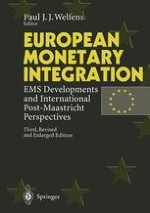1996 | OriginalPaper | Chapter
Creating a European Central Bank After 1992: Issues of EC Monetary Integration and Problems of Institutional Innovation
Authors : Paul J. J. Welfens, George M. von Furstenberg
Published in: European Monetary Integration
Publisher: Springer Berlin Heidelberg
Included in: Professional Book Archive
Activate our intelligent search to find suitable subject content or patents.
Select sections of text to find matching patents with Artificial Intelligence. powered by
Select sections of text to find additional relevant content using AI-assisted search. powered by
Founded at the end of the turbulent 1970s, the European Monetary System (EMS) goes into the 1990s with surprising (sometimes artificial) viability. Having successfully passed infancy in the 1980s the EMS now faces several challenges of adolescence, some of which are related to EC internal developments—above all “Project 1992”, the elimination of capital controls and the shift to an Economic and Monetary Union (EMU)—and others which concern a rapidly changing global environment. In June 1988, the European Council entrusted the later so-called Delors Commission to prepare a report on economic and monetary union in the EC; the Delors report received support at the Madrid EC summit in June 1989 which adopted stage I of the report: the removal of capital controls and the strengthening of intra-EC policy coordination. The deliberations within the EC do not point to a basic consensus with respect to an institutional framework for an EC central bank—a dual speed monetary integration scheme in which major continental EC countries would adopt a stability-oriented common monetary policy under the leadership of the German Bundesbank (central bank) seems to be possible.
